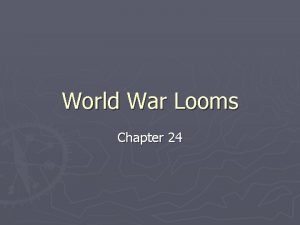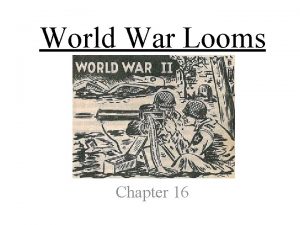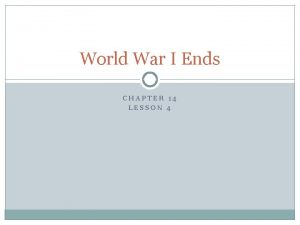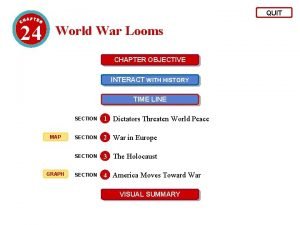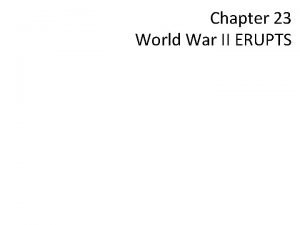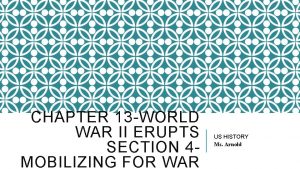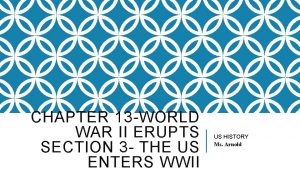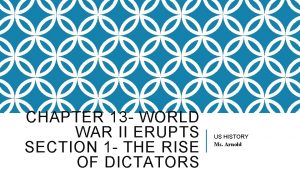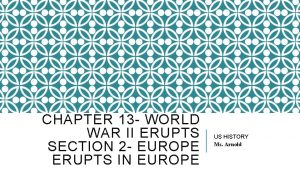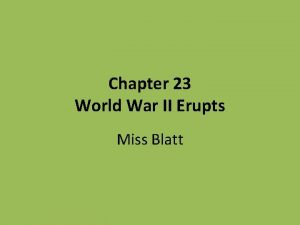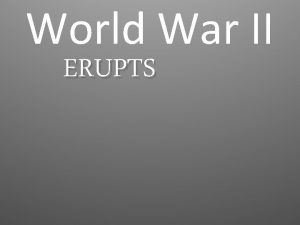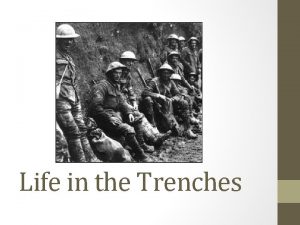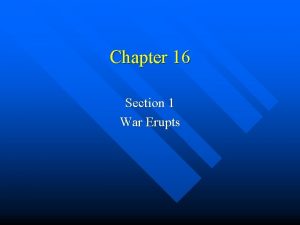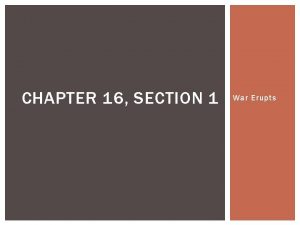World War II Erupts Chapter 23 The Rise













- Slides: 13

World War II Erupts Chapter 23 The Rise of Dictators Section 1

German Hyperinflation Europe after WWI One American dollar could buy about 9 German marks in 1919. By 1923, some paper mills anddeaths 2, 000 printing w World War 300 I caused the of presses were working around the clock to print money. millions and the destruction of numerous cities and farms. The Prices rose extremely fast. One customer at a café European economy was in ruins. ordered a cup of coffee at 5, 000 marks. By the time w ordered Germany was most affected bytothe he his second, the price had risen 7, 000 marks. Treaty of Versailles. A typical loaf of bread cost about 1 mark in 1920. By November 1, 1923 that bread might cost 3 billion marks. Two weeks later it would have risen to 80 billion marks.

Name three things that Mussolini and Hitler had inof Common? The Rise Totalitarian Leaders 1. Outraged by the Treaty of Versailles 2. w Dynamic speakers Leaders who reflected the people’s bitterness and anger emerged. 3. Strong leaders w These leaders promised a return to 4. Stressed nationalism greatness. 5. Used political skills and violence when necessary to gain power. 6. Glorified by citizens 7. Totalitarian Dictators

Benito Mussolini w Benito Mussolini led the Italian government by 1922. – His vision of a strong, orderly Italy was appealing w He founded the National Fascist Party. w Fascism stressed the glory of the state —the rights and concerns of individuals were of little importance. w Had total control over daily life in a totalitarian regime

Adolf Hitler was an Austrian who entered German politics because he was angry over the Treaty of Versailles. w Tried to seize power in Germany by force in 1923; revolt failed and he was sent to prison. w From prison, wrote Mein Kampf—a book that outlined his political ideas. – Believed in the racial superiority of the German people – Blamed the Jews for many of Germany’s problems

Adolf Hitler w Hitler became Germany’s chancellor in 1933. w Set up a totalitarian dictatorship w Secretly began to build up the German military

Other Totalitarian Regimes w. Spain Joseph Stalin—Soviet Union w. Japan Hideki Tojo--Japan

Soviet Union w Communism and fascism represent opposite political extremes. w Yet, under Joseph Stalin, communism was similar to fascism. He crushed all political opposition. w Stalin dominated all areas of Soviet life. w One of the era’s most notorious totalitarian dictators

Joseph Stalin w Stalin focused on creating a model Communist state in the Soviet Union by making agricultural and industrial restructuring. w In 1927 he got rid of all private enterprise especially private farming. w He forced Russia’s peasants to give up their small plots of land to form large state-owned farms. w His second main goal was to turn the Soviet Union into a great industrial power.

More Stalin w He turned the Soviet Union into a police state—a state in which no one was safe from the prying eyes and ears of Stalin’s spies and secret police. w Anyone even suspected of talking bad about the government or Stalin was shipped to Siberia to work. w During the great purge of the 1930 s tens of thousands of Communist Party officials, bureaucrats, and army officers were branded “enemies of the people” and were executed. w Historians believe that Stalin was responsible for between 8 million to 13 million deaths.

How did Hitler Justify rebuilding Germany’s. The Military? Rhineland He said that he was helping stop the spread of communism. w Germany could not have troops in an Why do you think. Rhine the British so eager to the area of the Riverwere valley along avoid war that they allowed Hitler to violate the French border. Treaty of Versailles and international law? w This was meant to protect France Devastation of WWI. against a possible German invasion. Determination avoidinto another w Hitler sent to troops the war. Rhineland in 1936. peace. Maintain Thought each violation would be the last one.

The Anschluss w In 1938 Hitler tried to unite the ethnic Germans of Austria with those of Germany. w He tried to force the Austrian government to agree to Anschluss – union with Germany w When the Austrian government refused, Hitler sent troops into the country. w No one stopped Hitler.

The Sudetenland w Hitler began plans to gain control of a German-speaking portion of Czechoslovakia. w He encouraged the Germans in the area to protest the Czech government and then threatened a military attack. w Neville Chamberlain and others allowed Hitler to annex the Sudetenland.
 Chapter 18 volcanic activity
Chapter 18 volcanic activity If a laboratory fire erupts immediately
If a laboratory fire erupts immediately Chemistry semester exam study guide
Chemistry semester exam study guide Rise and rise again until lambs become lions
Rise and rise again until lambs become lions Tricky dick
Tricky dick Rise and rise again until lambs become lions
Rise and rise again until lambs become lions Rise and rise again until lambs become lions origin
Rise and rise again until lambs become lions origin Chapter 30 the war to end war
Chapter 30 the war to end war Chapter 30 the war to end war
Chapter 30 the war to end war Chapter 16 world war looms vocabulary
Chapter 16 world war looms vocabulary Chapter 16 building vocabulary world war looms
Chapter 16 building vocabulary world war looms World war 1 and the russian revolution chapter 27
World war 1 and the russian revolution chapter 27 Chapter 27 lesson 4 world war 1 ends
Chapter 27 lesson 4 world war 1 ends Chapter 24 world war looms section 1 answers
Chapter 24 world war looms section 1 answers









